27.08.2019
'Rosalind Franklin' Mars rover assembly completed
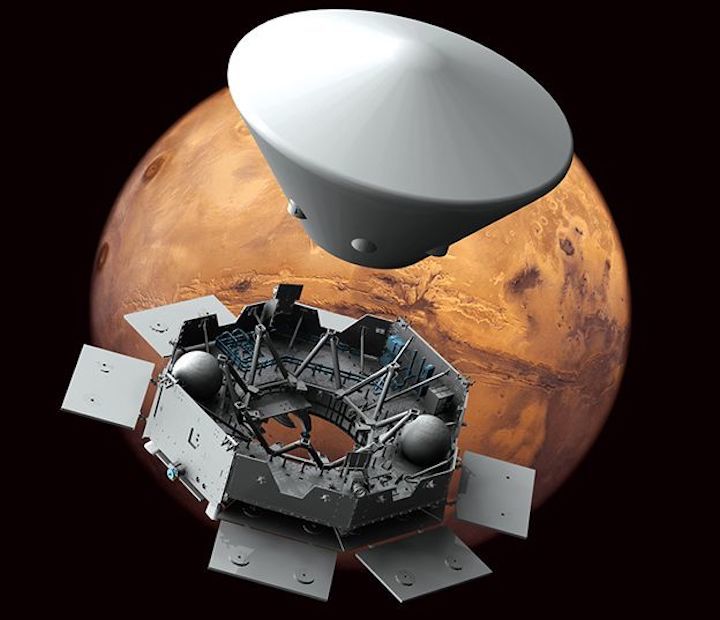
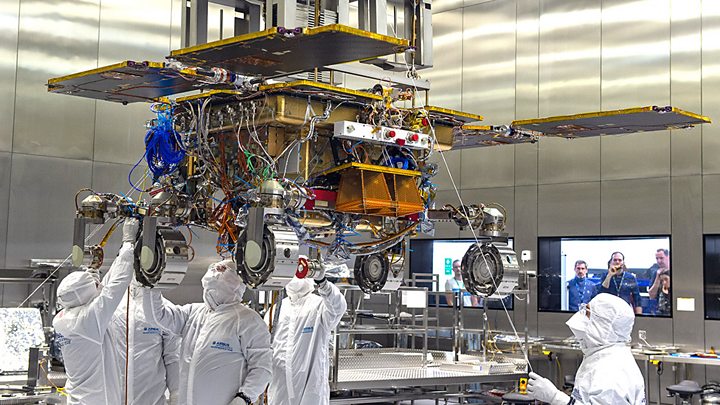
Assembly of the rover Europe and Russia plan to send to the Red Planet next year is complete.
Engineers at Airbus in Stevenage, UK, displayed the finished vehicle on Tuesday ahead of its shipment to France for testing.
Called "Rosalind Franklin" after the British DNA pioneer, the six-wheeled robot will search for life on Mars.
It has a drill to burrow 2m below ground to try to detect the presence of microbes, either living or fossilised.
The project is a joint endeavour of the European and Russian space agencies (Esa and Roscosmos), with input from the Canadians and the US.
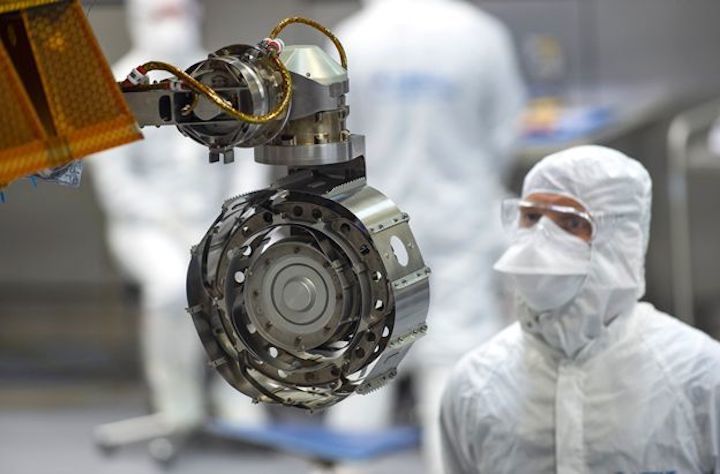
Although the rover's build took just nine months, development work at component and instrument level has consumed more than a decade (the initial feasibility study was started in 2004).
Lift-off atop a Proton rocket is scheduled for July 2020. It is an eight-month cruise to Mars, with the landing on an ancient equatorial plain targeted for 19 March, 2021, around 0600 local Mars time.
China and the US are preparing their own rovers for launch in the same departure window as Rosalind Franklin.
China's vehicle, dubbed XH-1, is a slightly smaller concept. The Americans are assembling a near-copy of the one-tonne Curiosity robot that has been investigating the Red Planet for the past seven years. Their machine is codenamed currently simply Mars 2020.
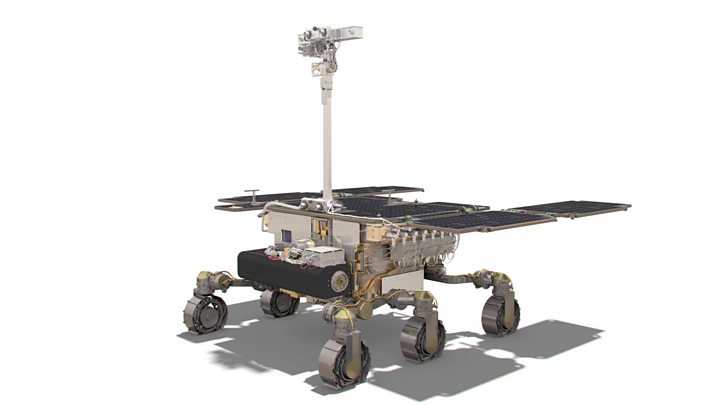
What still needs to be done?
The roughly 300kg Rosalind Franklin rover is being bagged and boxed, ready to be sent to an Airbus facility in Toulouse this week. It's in southwest France that a series of checks will ensure the robot can withstand the rigours of interplanetary travel and operation.
There are actually three outstanding items yet to be integrated on the rover.
These are the radioisotope heaters that will keep the vehicle warm in the bitter conditions on Mars. But they are a Russian expertise and will not be inserted until just prior to blast-off.
In parallel with the work on the rover, engineers in Italy at the Thales Alenia Space (TAS) company are preparing the mechanisms required to get the rover safely to, and on to, Mars.
In Turin on Wednesday, the German cruise spacecraft that will shepherd the robot to the Red Planet, and the Russian descent module, which will protect it as it enters Mars' atmosphere, will have their first fit-check.
Eventually, all elements of the mission will meet in Cannes, at another TAS factory, for end-to-end mating and balancing.
"When the spacecraft is sent to Mars, it will be spinning. Like the wheels on your car, we have to check the balance to make sure everything spins smoothly," explained Van Odedra, Airbus rover project manager.
The entire system should be despatched to the Baikonur launch site in April to begin the process of preparing for the Proton lift-off.
Rosalind Franklin was "superb scientific tool", said David Parker, Esa's director of human and robotic exploration.
"We still have big challenges ahead but mission success is our number one priority."
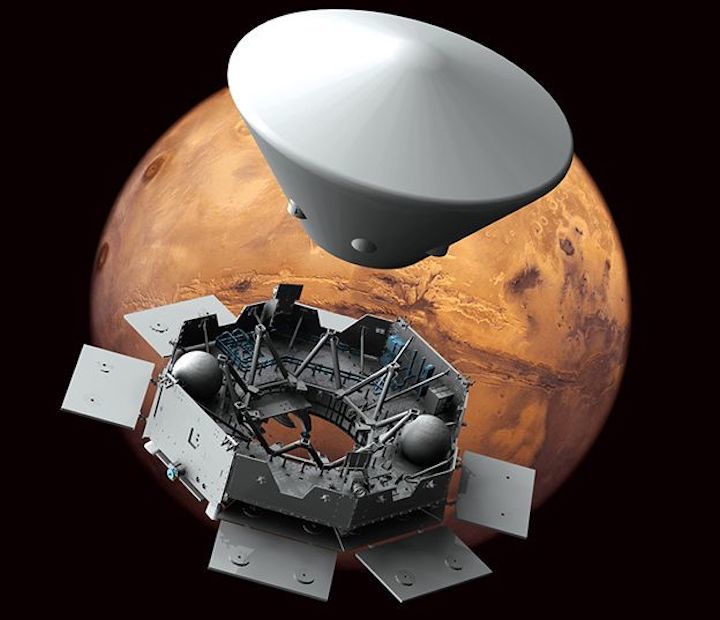
What's the critical next hurdle?
Currently, there is concern over the readiness of the parachute system that will slow Rosalind Franklin's descent through Mars' atmosphere to the surface.
Engineers have designed a two-chute system: a smaller supersonic envelope that opens first and a big subsonic membrane that opens once the entry speed has become manageable.
Two tests earlier this year - on both chute types - led to tearing on deployment.
Pietro Baglioni, Esa's ExoMars manager, said the problem appeared to stem from the way the parachutes were packed and then extracted - not from the nature of the material used to fabricate them.
Esa has called in Nasa to help with finding a solution because the American agency saw something similar during the development of the parachute system used on the successful Spirit and Opportunity rovers in 2004.
Further tests are planned for November and February.
The November demonstration will see engineers travel to Oregon for the launch of a stratospheric balloon.
This will drop a dummy mass from 30km in altitude; a mortar will fire the supersonic chute out of its container to simulate a Mars descent.
Mr Baglioni said the November test had "to show that the implemented corrective measures are at least on the right track. Going for a redesign of the entire parachute system is out of the question for a 2020 launch."
A formal "go/no-go" decision on the mission is expected early next year.
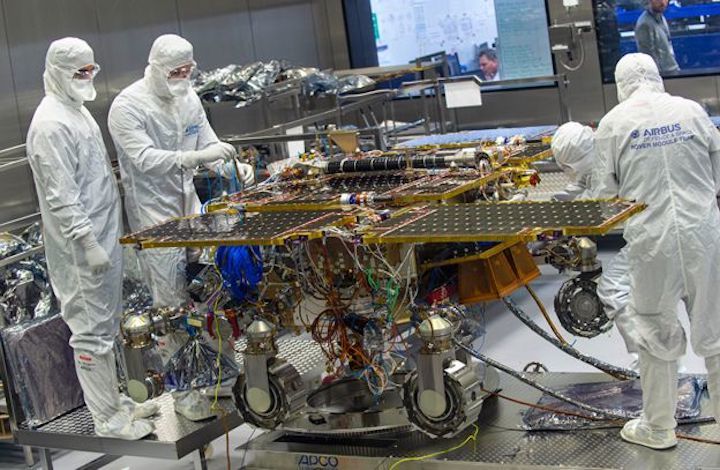
Why is Rosalind Franklin important for the UK?
Tuesday's send-off in front of the media was a big moment for the UK, which has made the Mars robot a central feature of its space science policy this past decade.
Britain has invested in the order of €290m (£260m) in the wider Esa-Roscosmos programme, codenamed ExoMars, that also includes a satellite positioned in orbit around the Red Planet. This satellite will act as the relay to send the rover's data home and, in the other direction, to feed Rosalind Franklin new commands.
A further £14m (€16m) of UK public money was also set aside specifically for instrument contributions on both the rover and the satellite.
UK scientists lead the PanCam (the panoramic camera system on the rover), for example, which will take the pictures that help the robot navigate Mars' terrain and identify the rocks of greatest interest.
With Rosalind Franklin now about to depart the country, there's intense interest in a follow-up.
Study work at Airbus-Stevenage is already considering the design of a rover that would pick up rock samples cached by Mars 2020 during its mission.
The aim would be to bring these samples back to Earth for a deeper analysis than is possible on Mars with remote laboratory tools.
The UK will tell its Esa partners when they gather in Spain in November for a major ministerial meeting that it will invest a substantial sum to secure the lead in building the "fetch rover", as it has become known.
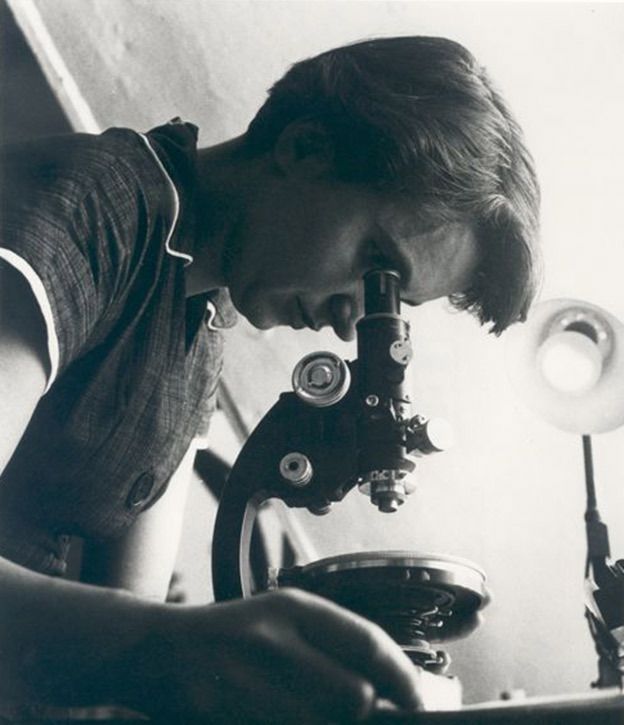
The rover is named after the British scientist who helped decipher the structure of DNA
Quelle: BBC
----
Update: 29.08.2019
.
EXOMARS ROVER READY FOR ENVIRONMENT TESTING
The Rosalind Franklin ExoMars rover has completed its construction activities in the UK and will now depart to France for testing under the conditions of the Red Planet’s environment.
The final pieces of the rover’s scientific suite of instruments were attached at the Airbus Defence and Space site in Stevenage over the last weeks. The finishing touches included the ‘eyes’ of the rover: the high-resolution cameras that will provide panoramic and close-up images of the terrain that the rover will explore once on Mars in 2021.
The primary goal of the mission is to determine if there has ever been life on Mars, and to better understand the history of water on the planet. The rover will seek out interesting geological locations to examine with its scientific tools and to drill to retrieve underground samples, on a quest to tackle these questions.
As such, the rover was assembled in a sterile cleanroom under stringent cleanliness rules to avoid that organics, including traces of human life, are accidentally carried to Mars and contaminate the samples.
After 18 months of activities at Stevenage, the rover has now been sealed up and waved off from the UK. Its next stop is Airbus Toulouse, France where it will undergo four months of intense testing to confirm it is compatible with the mission operations and the martian environment.
“Completing the build of the Rosalind Franklin rover under the strict cleanliness requirements, with all the science instruments onboard, is a major milestone of our ExoMars programme. It is thanks to the dedication of all the teams involved that we are able to celebrate this moment today,” says David Parker, ESA’s Director of Human and Robotic Exploration.
“We’re looking forward to completing the final rounds of tests before the rover is declared flight ready and closed inside the landing platform and descent module that will deliver it safely to the surface of Mars.”
Replicating Mars on Earth
The next round of tests will be conducted on vibration benches and in a chamber to simulate the range of environmental conditions expected on Mars. The rover’s instruments must work in an environment that is much harsher than experienced on Earth. For example, Rosalind Franklin can expect temperatures dropping to –120°C outside, and –60°C inside the rover. It must also be able to operate in less than one hundredth of Earth’s atmospheric pressure – and in a carbon dioxide-rich atmosphere.
In parallel the composite spacecraft comprising the carrier module, descent module, surface science platform and a replica rover will also undergo environmental testing to confirm it is ready to endure the environment of space on its eight-month journey to Mars.
Last year the ‘structural and thermal model’ of the rover successfully completed a rigorous environmental test campaign. Earlier this year, the analytical laboratory that will process and analyse the drilled samples inside the rover also completed a series of tests to verify that the mechanisms and instruments during science operations can produce satisfactory results under these challenging conditions.
The mission is foreseen for launch in just under a year from now (the launch window is 26 July–13 August 2020) on a Russian Proton-M launcher, arriving at Mars in March 2021.
Quelle: ESA
----
Update: 29.08.2019
.
ExoMars rover leaves British factory, heads for testing in France
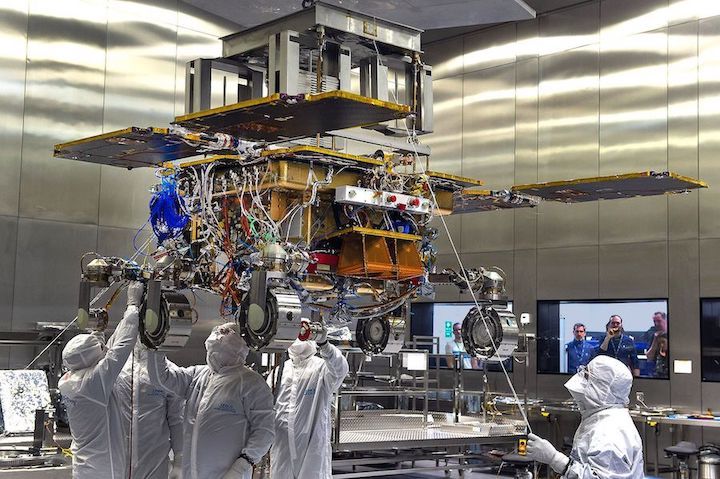
The European Space Agency’s ExoMars rover left its Airbus factory in Britain on Wednesday, heading for a round of testing in France before integration with its carrier and descent modules on pace for launch toward the Red Planet next July.
The nearly-complete rover is the centerpiece of the ExoMars mission, a joint robotic exploration project between ESA and Roscosmos, the Russian space agency.
The rover is named for Rosalind Franklin, a British chemist and X-ray crystallographer whose work contributed to the discovery of the twisting double helix shape of DNA molecule.
“Completing the build of the Rosalind Franklin rover under the strict cleanliness requirements, with all the science instruments onboard, is a major milestone of our ExoMars program,” said David Parker, ESA’s director of human and robotic exploration, in a statement. “It is thanks to the dedication of all the teams involved that we are able to celebrate this moment today.”
“We’re looking forward to completing the final rounds of tests before the rover is declared flight ready and closed inside the landing platform and descent module that will deliver it safely to the surface of Mars,” Parker said.
The Rosalind Franklin rover is Europe’s first Mars rover.
In launch configuration, the solar-powered robot weighs nearly 700 pounds (about 300 kilograms). The European rover is smaller than NASA’s Curiosity rover currently exploring Mars — along with NASA’s Mars 2020 rover set for launch next year — and somewhat larger than the Spirit and Opportunity rovers that landed on the Red Planet in 2004.
Teams at Airbus Defense and Space’s facility in Stevenage, England, north of London, assembled the Rosalind Franklin rover in a special ultra-clean factory over the last 18 months. The construction work capped more than a decade of design — and redesign — activities to prepare the ExoMars rover for its flight to Mars.
Airbus teams built the rover under strict cleanliness requirements, on top of the clean room standards for a typical space mission.
“The goal of ExoMars is to find life on the surface, more specifically under the surface, of Mars, and that means that we absolutely cannot take anything organic with us,” said Paul Meacham, the rover’s lead systems engineer at Airbus. “So that informs things like material choices. The wheels on the rover, for example, are metallic rather than being made of rubber. But that also means that when people are working on it, they must not in any way organically contaminate the rover.”
Over the last few months, engineers installed the rover’s scientific instruments, drill, a 3D panoramic camera suite, solar panels and wheels.
The Rosalind Franklin rover’s scientific payload includes instruments from Europe and Russia, with some component contributions from NASA. The instruments will study the make-up of the rocks and soil around the rover on Mars.
Teams at Airbus also installed the rover’s Analytical Laboratory Drawer, an instrument box which holds equipment to deliver rock and soil samples to three scientific instruments housed inside the container.
The rover’s six metallic wheels and drive system come from MDA in Canada, a division of Maxar Technologies.
The United Kingdom is the second-biggest financial contributor to the ExoMars program among ESA member states, after Italy, so Airbus’s Stevenage factory won the rights to the rover development.
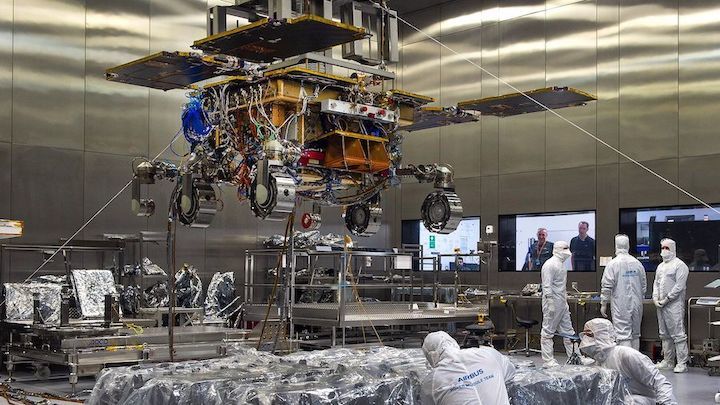
After leaving Airbus’s Stevenage plant, Rosalind Franklin rover’s next stop is at Airbus’s satellite factory in Toulouse, France, where it is due to arrive by truck Friday.
In Toulouse, engineers will place the rover on a vibration bench and in a thermal vacuum test chamber to verify the robot can withstand the rigors of spaceflight and the frigid environment of Mars, where temperatures will drop to minus 184 degrees (minus 120 degrees Celsius) outside, and minus 76 degrees Fahrenheit (minus 60 degrees Celsius) inside the rover, according to ESA.
The carbon dioxide-rich Martian atmosphere is about 100 times thinner than Earth’s.
The test campaign in Toulouse should last about four months, assuming everything goes according to plan, then officials will ship the rover to Thales Alenia Space in Cannes to meet the ExoMars mission’s German-built cruise stage and Russian descent module.
Engineers mated the cruise stage and descent module for the first time this week at a Thales Alenia Space facility in Turin, Italy, where the hardware will undergo its own test series over the coming months before shipping to Cannes, where engineers will add the rover.
While the major pieces of the ExoMars mission are coming together in Europe, engineers are struggling to confirm the readiness of the lander’s parachutes, which will slow the spacecraft before touchdown on Mars. The two most recent ExoMars parachute tests — in May and earlier this month — resulted in tears to the chutes.
On the most recent test, conducted over Sweden on Aug. 5, the largest of the four parachutes needed to deliver the ExoMars lander to the surface of Mars suffered damage to its canopy. As a result, the test vehicle used in the parachute test descended under the aerodynamic drag of only the much smaller pilot chute, ESA said.
Read our earlier story on the ExoMars parachute testing.
Two more parachute tests are planned later this year and in early 2020. If both tests produce satisfactory results, ESA officials will give the green light to ship the ExoMars spacecraft to the Baikonur Cosmodrome in Kazakhstan for final launch preparations.
ESA says the launch window for the ExoMars lander and rover opens July 26, 2020, and runs for less than three weeks. If the mission misses next year’s window, the next launch opportunity is in 2022.
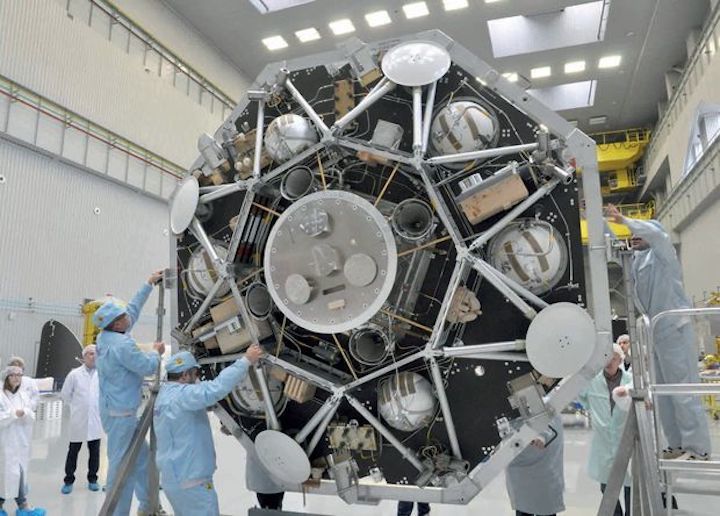
The ExoMars program consists of two parts.
The ExoMars Trace Gas Orbiter launched in March 2016 on a Russian Proton rocket and is now surveying the Martian atmosphere with suite of scientific instruments to search for methane, and a camera to map changes on the planet’s surface. The Trace Gas Orbiter launched aboard a Russian Proton rocket in tandem with a landing craft named Schiaparelli, which crashed on the Red Planet on final descent.
Like its orbiter precursor, the second ExoMars mission will launch on a Russian Proton booster from Kazakhstan.
After landing, the Russian descent stage will remain operational as a stationary lander platform — named Kazachok, Russian for “little Cossack” — to conduct its own scientific measurements, while the European rover will drive several kilometers and drill to a depth of 2 meters (6.6 feet) to collect core samples for analysis in the mobile robot’s on-board laboratory.
Scientists have never studied material from so deep below the Martian surface, where biomarkers and organic molecules could survive from life forms that may have inhabited the planet when it was warmer and wetter billions of years ago.
Quelle: SN
----
Update: 11.09.2019
.
Europe’s Mars lander parachute problems may be worse than thought
ESA has yet to conduct a successful test of the parachutes at supersonic speeds.
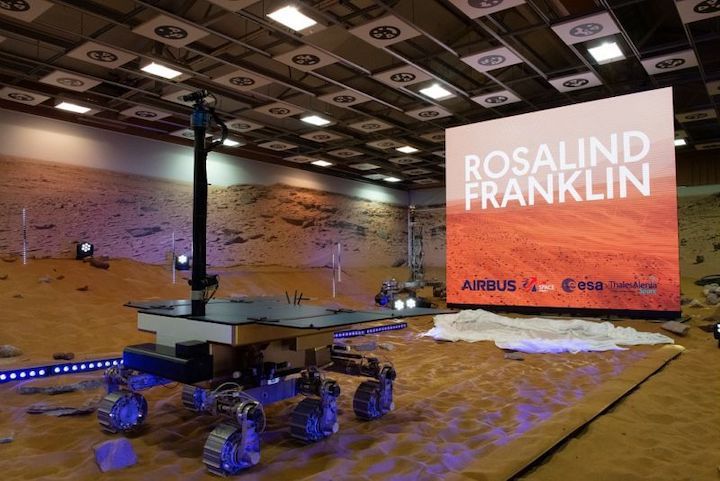
In October 2016, Europe's small Schiaparelli lander entered the Martian atmosphere and attempted to touch down on the surface of the red planet. Due to an altitude measurement error, however, the lander's parachute system was released early, and the lander crashed into Mars.
When it comes to Mars, this was just another in a long line of failures. Of the 21 landers sent by humans to Mars over the last six decades, only eight have successfully reached the red planet's surface and conducted science operations—all of which were built and launched by NASA.
Now, the European Space Agency is trying again, with its ExoMars mission due to be launched on a Proton rocket next summer. According to the space agency, the European-built Rosalind Franklin rover and the Russian-led surface platform, Kazachok, are nearly complete. They are due to go down to the Martian surface in a descent module. This spacecraft has a rather complicated sequence of parachute releases to slow the lander's descent through the thin Martian atmosphere.
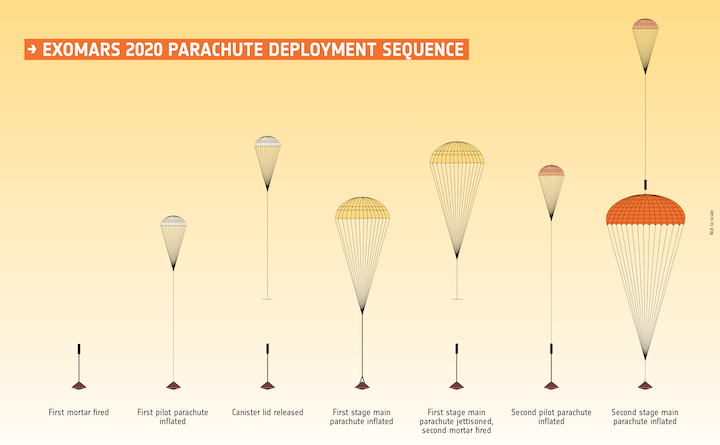
The first pilot parachute and the 15-meter main parachute are deployed while the lander is still traveling at supersonic speeds. The second set of pilot and main parachutes, which are larger, are deployed at subsonic speeds. This all happens rather quickly, as the entire landing sequence, from entering the Martian atmosphere, to touching down on the planet's surface, takes just six minutes.
Lots of test anomalies
The testing program has not gone particularly well. In May, damage occurred to both main parachute canopies during a high altitude drop test from 29km. After assessing the problem and making changes to the design of the parachutes and their bags, the agency conducted another high-altitude test on August 5th, this time focusing solely on the larger canopy that deploys in the lower atmosphere. This test, too, was not successful.
Despite these failures, European officials have publicly said they are pressing ahead toward a 2020 launch of the mission. “It is disappointing that the precautionary design adaptations introduced following the anomalies of the last test have not helped us to pass the second test successfully, but as always we remain focused and are working to understand and correct the flaw in order to launch next year," said Francois Spoto, ESA’s ExoMars Team Leader, in a news release.
The problems with the parachutes may be worse than has publicly been reported, however. Ars has learned of at least one other parachute failure during testing of the ExoMars lander. Moreover, the agency has yet to conduct even a single successful test of the parachute canopy that is supposed to deploy at supersonic speeds, higher in the Martian atmosphere.
Efforts to obtain a comment from the European Space Agency about this information, or the likelihood of a slip past present 2020 launch date, were unsuccessful. After a spokeswoman with the European Space Agency offered to look into the matter on September, 4, there has been no further response.
Quelle: arsTechnica
----
Update: 20.09.2019
.
ESA turns to NASA to assist in crucial ExoMars parachute tests
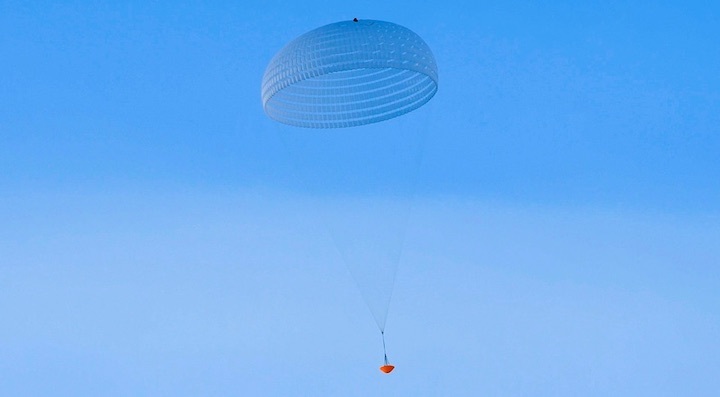
HELSINKI — The European Space Agency has sought assistance from NASA in a bid to qualify problematic parachutes that threaten the launch of the ExoMars 2020 mission.
ESA is preparing two new high-altitude tests of the supersonic and subsonic main chutes for the entry, descent and landing phase of the ExoMars mission, following failures in August and May.
The new tests, to be held in December and February, will test the 15-meter-diamater supersonic and 35-meter-wide subsonic parachutes needed to slow the descent of the ExoMars lander.
Both tests, to be held at high altitude to simulate the Martian atmosphere, need to succeed in order for the parachutes to pass qualification. TheExoMars mission faces a final review scheduled April 2020, Francois Spoto, ExoMars program manager, told SpaceNews.
“Now the situation is critical, of course, because we have limited time and no margin,” Spoto says.
If one of the tests fails, the ExoMars mission will miss the narrow July 25 to Aug. 13 launch window next year and slip to the next window, in late 2022. The lander and rover segments are meanwhile progressing well and ready for environmental testing.
ExoMars is to launch on a Russian Proton rocket and reach Mars in March 2021. It will employ a complex system of four parachutes, with two small pilot chutes used to sequential deploy the supersonic ‘disc–gap band’ chute and subsonic main chute.
In the first failed test, main chutes were found to have suffered damage prior to full loads being exerted. Measures to address the issues, including the addition of teflon to reduce frictional effects during release from bags, did not prevent damage being sustained during a second test.
ESA convened a workshop early September as part of efforts to identify and address the issues. Following this, inspectors from the Jet Propulsion Laboratory visited facilities involved in the parachute systems, Spoto says.
The findings from the JPL team indicate that the damage to the chutes was caused at the point of extraction from their bags. The failed tests also saw damage to cables holding the parachutes, but this was likely related to asymmetries resulting from the damage to the canopies.
“The focus is on adapting and simplifying the bag than touching the parachutes,” says Spoto. A meeting at European Space Research and Technology Center, ESTEC, in the Netherlands with industry partners involved in the parachute project was to be held Wednesday to decide the measures to be taken ahead of the next tests.
New tests in Oregon
While previous tests were held at the Esrange Space Center, northern Sweden, the new tests will take place in Oregon in the United States. Esrange closes late August due to conditions in the upper atmosphere and safety concerns related to dropping heavy components following the start of the local hunting season.
The ExoMars 2020 mission is a collaboration between ESA and Russia. The latter took the place of NASA, which pulled out of the mission in 2012 due to budgetary constraints.
The unprecedented size and complexity of the parachute system is related to the lander, being provided by Roscosmos. A more powerful retropropulsive system on the lander could have allowed the mission to require only one main chute, Spoto says.
The chutes will slow descent for the six-minute entry, descent and landing process, with the retropropulsion stage starting around 30-40 seconds prior to landing.
Spoto states that, given the apparent readiness of the Rosalind Franklin rover and lander spacecraft, missing the launch window due to the parachute would be a shame.
He adds however that Europe does not have a long line of planetary missions utilising parachutes, and the ExoMars missions are something of a one-off, making development a challenge.
A Mars sample return mission in collaboration with NASA will be one of the proposals for ESA’s Ministerial Council in November this year but, if approved, will not utilise a European-developed parachute.
NASA, China and the United Arab Emirates are also preparing to use the short launch window next year, determined by the relative positions of Mars and the Earth, to launch missions to the Red Planet.
Quelle: SN
----
Update: 16.10.2019
.
EXOMARS PARACHUTE PROGRESS
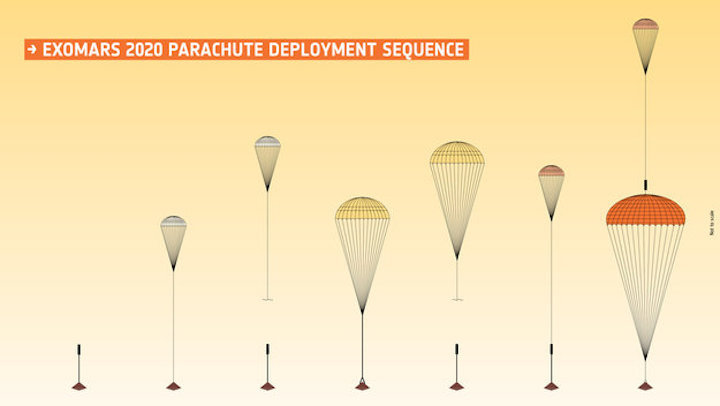
Positive steps towards solving the problems discovered with the ExoMars mission parachutes have been taken in the last month to keep on track for the July-August 2020 launch window.
The mission needs two parachutes – each with its own pilot chute for extraction – to help slow the descent module prior to landing on Mars. Once the atmospheric drag has slowed the descent module from around 21 000 km/h to 1700 km/h, the first parachute will be deployed. Some 20 seconds later, at about 400 km/h, the second parachute will open. Following separation of the parachutes about 1 km above ground the braking engines will kick in to safely deliver a landing platform – with a rover encapsulated inside – onto the surface of Mars for its scientific mission. The entire sequence from atmospheric entry to landing takes just six minutes.
While the deployment sequence of all four parachutes was successfully tested in high altitude drop tests earlier this year, damage to the 15 m-diameter primary parachute and 35 m-diameter secondary parachute canopy was observed. Despite precautionary design adaptations being introduced for a second test of the 35 m parachute, canopy damage occurred again.
A thorough inspection of all the recovered hardware has since been completed, allowing the team to define dedicated design adaptations to both primary and secondary main parachutes. Some promising design changes will also be applied to the parachute bags to ease the lines and canopy exit from the bags, avoiding frictional damage.
ESA has also requested support from NASA to benefit from their hands-on parachute experience. This cooperation gives access to special test equipment at NASA’s Jet Propulsion Laboratory that will enable ESA to conduct multiple dynamic extraction tests on the ground in order to validate any foreseen design adaptations prior to the upcoming high altitude drop tests.
The next opportunities for high altitude drop tests are at a range in Oregon, US, January–March. ESA is working to complete the tests of both the 15 m and 35 m parachute prior to the ExoMars project’s ‘qualification acceptance review’, which is planned for the end of April in order to meet the mission launch window (26 July–11 Aug 2020).
The qualified parachute assembly, inside its flight canister, should ideally be integrated into the spacecraft prior to shipment to Baikonur in April, but it is also possible to do so during the spacecraft preparation activities at the launch site in May.
The mission will launch on a Proton rocket, and a carrier module will transport the composite descent module, Kazachok lander platform and Rosalind Franklin rover to Mars, arriving in March 2021. After driving off the surface platform, Rosalind Franklin rover will explore the surface of Mars, seeking out geologically interesting sites to drill below the surface, to determine if life ever existed on our neighbour planet.
The rover is currently undergoing its environmental test campaign at Airbus Toulouse, France. At the same time, the flight carrier module containing the descent module and lander platform is completing its final round of testing at Thales Alenia Space, Cannes, France. The rover will be integrated into the spacecraft in early 2020.
All parachute system qualification activities are managed and conducted by a joint team involving the ESA project (supported by Technical Directorate expertise), TASinI (prime contractor), TASinF (PAS lead), Vorticity (parachute design and test analysis) and Arescosmo (parachute and bags manufacturing).
The ExoMars programme is a joint endeavour between ESA and Roscosmos. In addition to the 2020 mission, it also includes the Trace Gas Orbiter (TGO) launched in 2016. The TGO is already both delivering important scientific results of its own and relaying data from NASA’s Curiosity Mars rover and InSight lander. It will also relay the data from the ExoMars 2020 mission once it arrives at Mars in March 2021.
Quelle: ESA



